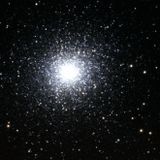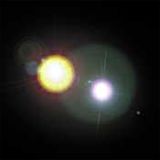
July 19-21, 2013 (Crater J. Herschel, Crater Flamsteed, Nu and Xi Scorpii, Sirsalis Rille and M22)
Friday, July 19
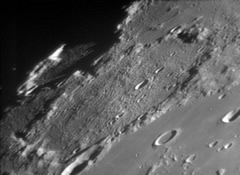
J. Herschel - Credit: Damian Peach
Tonight on the lunar surface, look around the 11:00 position for the readily apparent C-shape of Sinus Iridum. We're about to head north and go crater hopping!
The first hop is across Mare Frigoris and to the northeast past the punctuation of Harpalus. We're looking for a grand old crater - J. Herschel. Although it looks small because it is seen on the curve, this wonderful old walled plain named for John Herschel contains some very tiny details. Its southeastern rim forms the edge of Mare Frigoris and the small (24 km) Horrebow dots its southwest edge. The crater walls are so eroded with time that not much remains of the original structure. Look for many very small telescopic impact craters which dot J. Herschel's uneven basin and exterior edges. Power up! If you can spot the small central crater C, you are resolving a feature only 12 kilometers wide from some 385,000 kilometers away! Formed in the Pre-Nectarian period, this walled plain could be as much as 4 billion years old...
Saturday, July 20
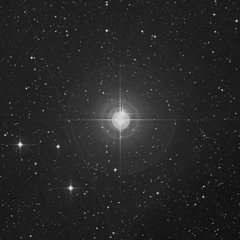
Nu and Xi Scorpii - Credit: Palomar Observatory, courtesy of Caltech
If you'd like a real telescopic lunar challenge tonight, look just south of central on Oceanus Procellarum, about halfway between Kepler and Gassendi, for a large crater which has mostly melted down. This "ghost crater" has no name, but look along its edge for Class I Flamsteed. It is very near here that Surveyor 1 still stands. It made its landing on June 2, 1966 and sent back more than 11,000 pictures of the rock strewn, desert-like floor. This area was one of the first chosen for an Apollo mission landing, but was later scratched for a more central location.
Now, let's take the opportunity to look at two multiple star systems - Nu and Xi Scorpii. Starting with Nu about a fingerwidth east and slightly north of bright Beta, we find a handsome duo of stars in a field of nebulosity that will challenge telescopic observers much the way that Epsilon Lyrae does. With any small telescope, the observer will easily see the widely separated A and C stars. Add just a little power and take your time... The C star has a D companion to the southwest! For larger telescopes, take a very close look at the primary star. Can you separate the B companion to the south?
Now let's hop to Xi, about four fingerwidths north of Beta. Discovered by Sir William Herschel in 1782, this 80 light-year distant system poses a nice challenge for mid-sized scopes. The yellow-hued A and B pair share a very eccentric orbit about the same distance as Uranus is from our Sun. During the 2007 observing year they should be fairly well spaced, and the slightly fainter secondary should appear to the north. Look a good distance away for the 7th magnitude orange C component and south for yet another closely-matched double of 7th and 8th magnitude - the D and E stars.
For the larger scope, this multiple star system does display a little bit of color. Most will see the A and B components as yellow or white, the C star as slightly orange, and the D/E pair as slightly tinged with blue. Be sure to mark your observations, for this is one of the finest!
Sunday, July 21
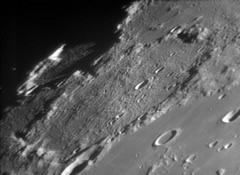
Sirsalis - Credit: Damian Peach
For larger telescopes, let's try a challenging lunar study worthy of your observing skills. Due west of Hansteen, you will find a small crater known as Sirsalis located near the terminator. It will appear as a small, dark ellipse with a bright west wall along with its twin, Sirsalis B. The feature you will be looking for is the Sirsallis Rille - the longest lunar "wrinkle" presently known.
Stretching northeast of Sirsalis and extending 459 kilometers south to the bright rays of Byrgius, this major "crack" in the lunar surface shows several branchings - like a long dry river bed. Geologically forming in the Imbrian period, chances are the Sirsalis Rille is lunar graben. Thanks to Lunar Orbiter images, the evidence points to shifting tectonic plates as the source of this incredible feature.
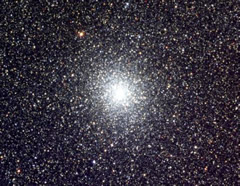
M22 - Credit: N.A.Sharp, REU program/NOAO/AURA/NSF
Now, let's continue our exploration of globular clusters. These gravitationally bound concentrations of stars contain anywhere from ten thousand to one million members, and attain sizes of up to 200 light-years in diameter. At one time, these fantastic members of our galactic halo were believed to be round nebulae. Perhaps the very first to be discovered was M22 by Abraham Ihle in 1665. This particular globular is easily seen in even small binoculars and can be located just slightly more than two degrees northeast of the "teapot's lid," Lambda Sagittarii.
Ranking third amongst the 151 known globular clusters in total light, M22 (Right Ascension: 18:36.4 - Declination: -23:54) is probably the nearest of these incredible systems to our Earth with an approximate distance of 9,600 light-years, and it is also one of the nearest globulars to the galactic plane. Since it resides less than a degree from the ecliptic, it often shares the same eyepiece field with a planet. At magnitude 6, the class VII M22 will begin to show individual stars to even modest instruments and will burst into stunning resolution for larger aperture. About a degree west-northwest, mid-sized telescopes and larger binoculars will capture smaller 8th magnitude NGC 6642 (Right Ascension: 18:31.9 - Declination: -23:29). At class V, this particular globular will show more concentration toward the core region than M22. Enjoy them both!
Until next week, wishing you clear skies!
Tammy Plotner is a professional astronomy author, President Emeritus of Warren Rupp Observatory and retired Astronomical League Executive Secretary. She's received a vast number of astronomy achievement and observing awards, including the Great Lakes Astronomy Achievement Award, RG Wright Service Award and the first woman astronomer to achieve Comet Hunter's Gold Status.
Leave us a comment about your favorite object in this guide.




